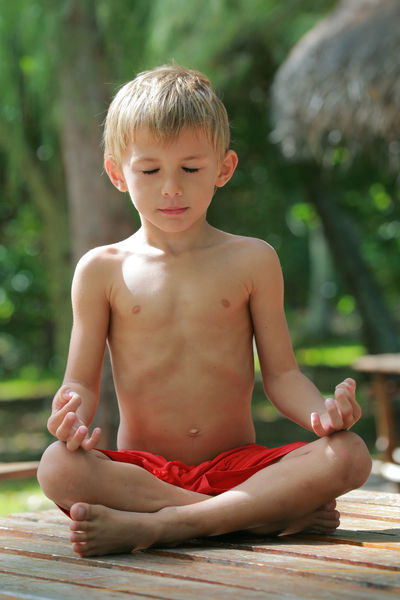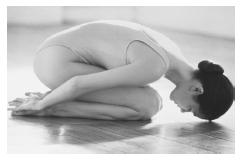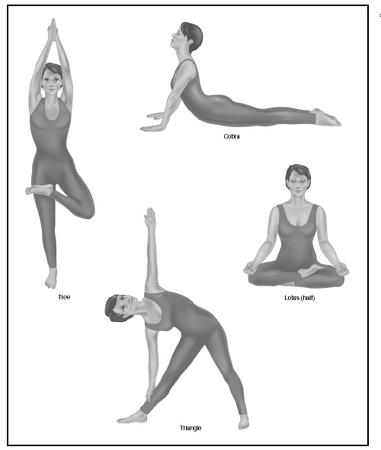Yoga

Definition
Yoga is an ancient system of breathing practices, physical exercises and postures, and meditation intended to integrate the practitioner's body, mind, and spirit. It originated in India several thousand years ago, and its principles were first written down by a scholar named Patanjali in the second century B.C. The word yoga comes from a Sanskrit word, yukti , and means "union" or "yoke." The various physical and mental disciplines of yoga were seen as a method for individuals to attain union with the divine.
In the contemporary West, however, yoga is more often regarded as a beneficial form of physical exercise than as a philosophy or total way of life. As of 2002, more than six million people in the United States were practicing some form of yoga, with 1.7 million claiming to practice it regularly.
Purpose
Yoga has been recommended as an adjunct to psychotherapy and standard medical treatments for a number of reasons. Its integration of the mental, physical, and spiritual dimensions of human life is helpful to patients struggling with distorted cognitions or pain syndromes. The stretching, bending, and balancing involved in the asanas (physical postures that are part of a yoga practice) help to align the head and spinal column; stimulate the circulatory system, endocrine glands, and other organs; and keep muscles and joints strong and flexible. Yoga programs have been shown to reduce the risk of heart disease by lowering blood pressure and anxiety levels. The breath control exercises, known as pranayama , emphasize slow and deep abdominal breathing. They benefit the respiratory system, help to induce a sense of relaxation, and are useful in pain management. The meditation that is an integral part of classical yoga practice has been shown to strengthen the human immune system. Although Western medical researchers have been studying yoga only since the 1970s, clinical trials in the United States have demon strated its effectiveness in treating asthma, osteoarthritis, heart disease, stress-related illnesses, high blood pressure, anxiety, and mood disorders. Other reports indicate that yoga merits further research in the treatment of obsessive-compulsive disorder (OCD) and substance abuse. Studies done in Germany have focused on the psychological benefits of yoga. One clinical trial done in 1994 at the University of Wurzburg found that the volunteer subjects who had practiced yoga scored higher in life satisfaction, with lower levels of irritability and pychosomatic complaints, than the control group.
One of the advantages of yoga as a complementary therapy is its adaptability to patients with a wide variety of physical and psychiatric conditions. There are a number of different schools of yoga—over 40, according to one expert in the field—and even within a particular school or tradition, the asanas and breathing exercises can be tailored to the patient's needs. One can find special yoga courses for children; for people over 50; for people with fibromyalgia, arthritis, or back problems; for cancer patients; and for people struggling with weight. Although most people who take up yoga attend classes, it is possible to learn the basic postures and breathing techniques at home from beginners' manuals or videotapes. Patients who feel self-conscious about exercising in the presence of others may find yoga appealing for this reason. The American Yoga Association has produced a manual and videotape for beginners, as well as a book called The American Yoga Association's Easy Does It Yoga for persons wih physical limitations. In addition, yoga does not require expensive equipment or special courts, tracks, or playing fields. An area of floor space about 6 ft by 8 ft, a so-called "sticky mat" to keep the feet from slipping, and loose clothing that allows the wearer to move freely are all that is needed.
Precautions
Patients with a history of heart disease, severe back injuries, inner ear problems or other difficulties with balance, or recent surgery should consult a physician before beginning yoga. Pregnant women are usually advised to modify their yoga practice during the first trimester.
People diagnosed with a dissociative disorder should not attempt advanced forms of pranayama (yogic breathing) without the supervision of an experienced teacher. Some yogic breathing exercises may trigger symptoms of derealization or depersonalization in these patients.
Yoga should not be practiced on a full stomach. It is best to wait at least two hours after a meal before beginning one's yoga practice. In addition, while yoga can be practiced outdoors, it should not be done in direct sunlight.
One additional precaution is often necessary for Westerners. Yoga is not a competitive sport, and a "good" practice is defined as whatever one's body and mind are capable of giving on a specific day. Westerners are, however, accustomed to pushing themselves hard, comparing their performances to those of others, and assuming that exercise is not beneficial unless it hurts— an attitude summed up in the phrase "no pain, no gain." Yoga teaches a gentle and accepting attitude toward one's body rather than a punishing or perfectionistic approach. A person should go into the stretches and poses gradually, not forcibly or violently. Stretching should not be done past the point of mild discomfort, which is normal for beginners; frank pain is a warning that the body is not properly aligned in the pose or that the joints are being overstressed. Most people beginning yoga will experience measurable progress in their strength and flexibility after a week or two of daily practice.

Description
There are six major branches of yoga: hatha, raja, karma, bhakti, jnana, and tantra yoga. Hatha yoga, the type most familiar to Westerners, will be discussed more fully in the following paragraph. Raja yoga is a spiritual path of self-renunciation and simplicity; karma yoga emphasizes selfless work as a service to others. Bhakti yoga is the path of cultivating an open heart and single-minded love of God. Jnana yoga is the sage or philosopher's approach; it cultivates wisdom and discernment, and is considered the most difficult type of yoga. Tantra yoga emphasizes transcending the self through religious rituals, including sacred sexuality.
Hatha yoga is the best-known form of yoga in the West because it is often taught as a form of physical therapy. A typical hatha yoga practice consists of a sequence of asanas, or physical poses, designed to exercise all parts of the body in the course of the practice. The asanas incorporate three basic types of movement: forward bends, backward bends, and twists. Practitioners of hatha yoga have over 200 asanas to choose from in creating a sequence for practice. The postures have traditional Indian names, such as Eagle Pose, Half Moon Pose, or Mountain Pose. There are steps for entering and leaving the pose, and the student is taught to concentrate on proper form and alignment. The pose is held for a period of time (usually 10–20 seconds), during which the practitioner concentrates on breathing correctly. Mental focus and discipline is necessary in order to maintain one's poise and balance in the asana. At the close of the practice, most students of yoga rest in a position that allows for a period of meditation. Most yoga practices take about an hour, although some are as short as 20 minutes.
There are a number of different styles of hatha yoga taught in the United States, the best known being Iyengar,

Preparation
Good preparation for yoga requires spiritual and mental readiness as well as appropriate clothing and a suitable space. Many practitioners of yoga begin their practice with simple breathing exercises and stretches intended to clear the mind as well as open up the lungs.
Clothing should be comfortable and allow free movement. Some women prefer to practice in a dancer's leotard or similar garment made of stretchy fabric, but a simple tunic or beach cover-up worn over a pair of running shorts works just as well. Brassieres should not be worn during practice because they tend to restrict breathing. Men often practice in swim trunks or running shorts. Both men and women can use an oversize men's cotton T-shirt as a practice garment— these are inexpensive, easy to wash, and nonbinding. The feet are bare.
Aftercare
As was mentioned earlier, traditional hatha yoga practice ends the sequence of asanas with a pose in which meditation is possible, either sitting or lying flat on the back. Other than quiet resting, no particular aftercare is necessary.
Risks
Most reported injuries in yoga result from lack of concentration or attempts to perform difficult poses without working up to them. People who have consulted a physician before starting yoga and practice under the supervision of an experienced teacher are unlikely to suffer serious injury.
Normal results
Normal results following yoga practice are improved posture, lowered blood pressure, increased flexibility in the joints, higher energy levels, and a sense of relaxation.
Abnormal results
Abnormal physical results would include serious injuries to joints or muscles; abnormal psychological results would include dissociative episodes.
Resources
BOOKS
Choudhury, Bikram, with Bonnie Jones Reynolds. Bikram's Beginning Yoga Class. New York: Jeremy P. Tarcher/Perigee, 1978.
Feuerstein, Georg, and Stephan Bodian, eds. Living Yoga: A Comprehensive Guide for Daily Life. New York: JeremyP. Tarcher/Perigee, 1993.
Pelletier, Kenneth R., MD. "Ayurvedic Medicine and Yoga: From Buddha to the Millennium." Chapter 10 in The Best Alternative Medicine. New York: Simon and Schuster,2002.
PERIODICALS
Janakiramaiah, N., B. N. Gangadhar, P. J. Naga Venkatesha Murthy, and others. "Antidepressant Efficacy of Sudarshan Kriya Yoga (SKY) in Melancholia: A Randomized Comparison with Electroconvulsive Therapy (ECT) and Imipramine." Journal of Affective Disorders 57 (January-March 2000): 255–259.
Shaffer, H. J., T. A. LaSalvia, and J. P. Stein. "Comparing Hatha Yoga with Dynamic Group Psychotherapy for Enhancing Methadone Maintenance Treatment: A Randomized Clinical Trial." Alternative Therapies in Health and Medicine 3 (July 1997): 57–66.
Shannahoff-Khalsa, D. S., and L. R. Beckett. "Clinical Case Report: Efficacy of Yogic Techniques in the Treatment of Obsessive-Compulsive Disorders." International Journal of Neuroscience 85 (March 1996): 1–17.
ORGANIZATIONS
American Yoga Association. <www.americanyogaassociation.org> .
International Association of Yoga Therapists (IAYT). 4150 Tivoli Avenue, Los Angeles, CA 90066.
Yoga Research and Education Center (YREC). 2400A County Center Drive, Santa Rosa, CA 95403. (707) 566-0000. <www.yrec.org> .
Rebecca J. Frey, Ph.D.
Comment about this article, ask questions, or add new information about this topic: